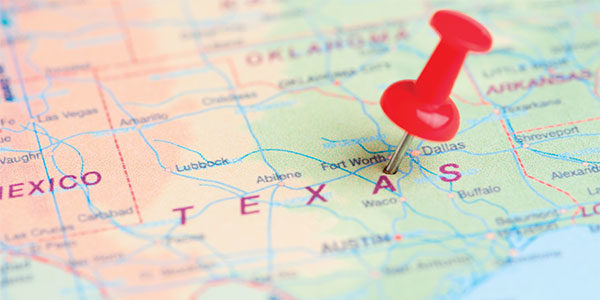Texas wants you anyway

If industrial real estate experts and state business development officials are to be believed, that sentiment also holds true for companies seeking a location for their next distribution facility. The state welcomes new business with open arms, relatively low costs, and a favorable tax environment.
Or as Mabrie Johnson from the economic development organization North Texas Commission bluntly puts it: "The only reason why you wouldn't want to come to Texas is you're crazy."
CENTRAL LOCATION
So just what does Texas have going for it? Where industrial site selection is concerned, quite a lot, says Tom Sanderson, CEO of the Dallas-based third-party logistics service provider Transplace. When companies go to choose a DC location, they typically concentrate on such factors as geography, transportation infrastructure, labor supply and costs, and business environment, Sanderson says. "The great thing about Texas," he adds, "is you can check off almost every box."
The first "box" that Sanderson (and most location experts) check off is location. Texas's central location makes it relatively easy to reach consumer markets all across the country. On top of that, the state has a large and growing consumer market of its own. Six of the country's 20 most populous cities are in Texas: Houston, San Antonio, Dallas, Austin, Fort Worth, and El Paso. Four of those cities—Austin, Houston, San Antonio, and Dallas—also rank in the top 10 fastest-growing major cities in the United States, according to Forbes magazine.
Texas also has undeniable geographic advantages for companies engaged in international trade, particularly with Mexico. Mexico has been benefiting from the growth of "nearshoring," as more and more companies bring manufacturing back from Asia and closer to consumer markets in North America, reports Marcel Johnson, vice president of business development at industrial developer Port San Antonio. That, in turn, has benefited Texas. Many of the goods being manufactured in Mexico, particularly automotive components, are then brought into Texas for distribution to the rest of the United States or are being partially made in Mexico and partially in Texas, Johnson says.
For this reason, the border towns of Laredo and El Paso have increasingly become hotbeds of logistics and distribution center activity. Growth in trade with Mexico has also sparked a boomlet in the DC market in Dallas-Fort Worth, as the metropolis has proved to be an attractive consolidation point for Mexican-made goods heading north on I-20 or east/west on I-35.
It's important to note that Texas's international trade is not one-sided. According to the state's Office for Economic Development & Tourism, Texas is the country's top exporting state, with more than $297.7 billion in exports. Texas's top export partners are Mexico, Canada, Brazil, China, and the Netherlands; its principal exports include petroleum and coal, chemicals, computers, nonelectrical machinery, and transportation equipment.
ROBUST INFRASTRUCTURE
In addition to being centrally located, Texas also boasts one of the strongest transportation networks in the U.S. "From a pure logistics standpoint, you can 'get there from here,'" says Terry Darrow, managing director of industrial real estate firm Jones Lang LaSalle's Dallas office.
For example, Texas has over 3,000 miles of highways, more than any other state. "We also do a fairly good job of overbuilding our roadways," says Will Condrey, associate director for the Houston office of Cushman & Wakefield, an industrial real estate firm. "We do not have, like a lot of other markets, heavy-haul corridors, and as result of that, trucks are welcome on all major thoroughfares."
Texas is also home to the second-longest rail system in the country and is served by three Class I railroads: the Union Pacific, the Kansas City Southern, and the Fort Worth-based BNSF Railway. The rail system connects Texas to both coasts as well as to Mexico. Rail service is supported by a network of intermodal facilities across the state, including two—the Alliance Global Logistics Hub in the Dallas/Fort Worth area and Port San Antonio—that boast high-capacity industrial airports, Class I rail terminals, and direct access to interstate highways.
The state also has excellent short-line rail service, which can bring freight right to a company's doorstep, according to Darrow.
For oceangoing freight, the state is home to the 12th-busiest port in the world: the Port of Houston. Historically, the port has been associated with exports, particularly of petroleum and petroleum products. But lately, a growing population base has created strong demand for imports. As a result, says John Moseley, the port's senior director of trade development, imports and exports are fairly well balanced.
The state also provides excellent aircargo service. The Dallas/Fort Worth International Airport (DFW) alone handles more than $50 billion worth of cargo annually, mostly high-value items like semiconductors, cell phones, and aircraft parts. According to Mabrie Johnson, you can reach anywhere in the continental United States in approximately four hours by air from DFW, which has been recognized as the best cargo airport in North America by Air Cargo World magazine. The state is also served by Alliance Airport, the first purely industrial airport in the world.
A BUSINESS-FRIENDLY CLIMATE
Texas also has a well-deserved reputation for being business-friendly and possesses a pro-business government structure. The state does not have a corporate or individual income tax, and many county, city, and local authorities offer generous tax abatement programs to encourage job creation. The state also offers healthy industrial development incentive programs, such as the Texas Enterprise Fund, which is the largest "deal-closing" fund of its kind in the nation, and The Texas Skills Development Fund, which provides financing for customized job training programs.
Texas also has a strong supply of labor, with a civilian work force of more than 13 million people, the second largest (and one of the youngest) in the country. Furthermore, Texas is a "right to work" state, meaning that workers cannot be required to join a labor union in order to be employed, and overall union participation is relatively low.
Beyond all that, the state can offer companies space to grow. Unlike California, New York, or New Jersey, there is still land available for greenfield distribution sites near major cities. As a result, land costs and occupancy costs are reasonable compared with prices in metropolitan areas of a similar size. "We still have relatively cheap dirt," says Condrey of Cushman & Wakefield.
THE PROMISED LAND?
Yet Texas is not without its flaws. Many of the state's boosters tout the job-training programs created by government agencies, local community colleges, and business. However, the picture is not so bright when it comes to the school system in the state, according to a report by the Texas Legislative Study Group, Texas on the Brink. The 2013 report found that Texas ranks 50th in the percentage of its citizens who have graduated from high school and 44th in high school graduation rates. Additionally, the study reports that Texas has the highest percentage of uninsured adults in the nation and generates the most hazardous waste and carbon dioxide emissions.
But considering the state's central location, robust infrastructure, low land costs, and access to available labor, industrial site selection experts can perhaps be forgiven for overlooking these weaknesses. Or as Lovett sings: "So pardon me my laughter/ 'Cause I sure do understand/ Even Moses got excited/ When he saw the promised land."
Related Articles

Copyright ©2024. All Rights ReservedDesign, CMS, Hosting & Web Development :: ePublishing